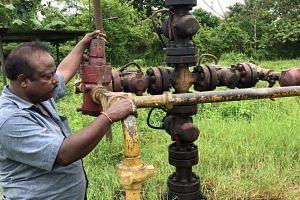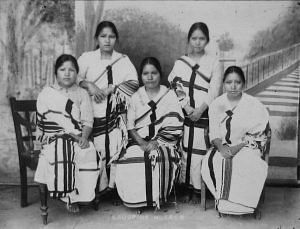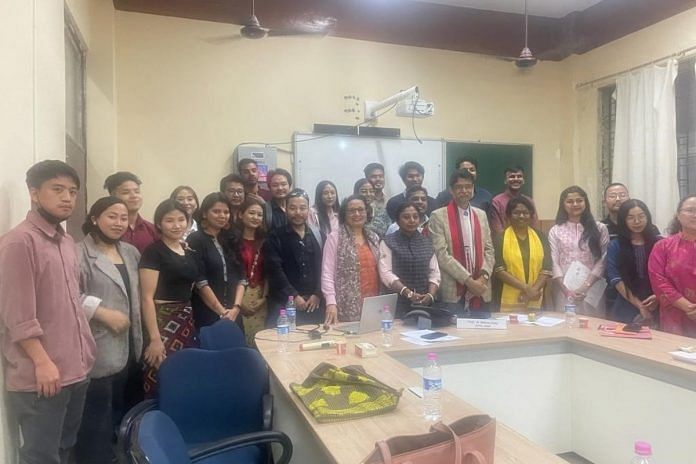The Rajiv Gandhi University at Rono Hills in Arunachal Pradesh has never had it so good. Its two-floor library has over 80,000 books, 500 PhD theses and 300 MPhil dissertations, all neatly bound.
Just a decade ago, the library shelves were almost bare of research from the region. It just wasn’t the robust resource centre for scholars that it aspired to be.
But over the last few years, a massive shift has occurred in the academic canon of India’s Northeast. There is a profusion of quality scholarship now by young scholars and authors. From a magnum opus on the Brahmaputra river to the forgotten wars of the region to how memory is constructed in Manipur, conferences and seminars are buzzing with this new wave of knowledge production about the seven states by people from the seven states.
“Some of the new research has been asking hard questions and pointing to fascinating historical, cultural and economic connections that unsettle perceived notions of what constitutes communities, regions and nations,” said Tanmoy Sharma, a young PhD scholar in anthropology from Yale University.
Most of the papers at RGU are the research output of students from the central university particularly those from Arunachal Pradesh. The varsity’s roster of publications shows its instrumental role in creating new academic energy and space.
Academics are vying to explore the Northeast
This scholarship is not simply languishing in libraries or being relegated to trade publications. RGU and other institutions are actively spreading the word. Conferences and seminars held in cities like Tezpur, Itanagar and even Delhi are showcasing this new knowledge. And everyone, from the Indian Institutes of Technology to Harvard University in the United States, is eager to collaborate.
The university’s anthropology department recently teamed up with IIT-Gandhinagar to organise a national conference called ‘Tribes, State and the Environment: Contemporary Research from India’s North East’ in Doimukh near Itanagar.
Considering how niche the subject was, the response was surprisingly overwhelming.
“We received more than a hundred abstracts from scholars working on the Northeast from across the world,” said Dr Sarit K Chaudhary, head of the anthropology department at RGU.
One submission linked cultural beliefs to snake preservation among the Monpa tribe of Arunachal Pradesh. Another explored the impact of jhum cultivation, where land is cleared by burning vegetation.
Earlier in January, an ambitious, well-attended conference called ‘Interrogating the Indigenous in Northeast India’ in New Delhi— organised by the Lakshmi Mittal and Family South Asia Institute, Harvard University, brought diverse voices from Yale University, IIT-Guwahati and the University of Edinburgh.
Post-lunch sessions in most conferences or seminars usually become sleepy affairs. But this one proved to be different. Fortified after the break, the audience returned to make insightful comments and ask thought-provoking questions. There was never a dull moment. After a session on the significance of symbols like the ‘dhul’ (a musical instrument) and celebrations as a political and aggressive act, a student from the audience stood up to present a nuanced counter view.
“We have to look at the history of the Northeast both from a sense of attachment as well as detachment,” said Mondeep Borah, a second year student at Delhi University’s Sri Guru Teg Bahadur Khalsa College.
Even after the day-long seminar ended, people could be seen in corners and on the ground outside the building, discussing and dissecting the various panel discussions they had attended.
“It is not often that we have scholarly exchanges of this quality about the Northeast.” said political-historian Sugata Bose from Harvard University, who chaired a session.
Even five years ago, conferences like these were rare, and participation used to be even less. But there is a greater public engagement now on issues in the Northeast.This new growth coincides with increased public and political attention on the region—its history, warriors and ancient mounds.
It’s also permeating the publishing industry, not in the form of dense scholarly papers but engaging non-fiction aimed to catch the lay reader’s attention.
Also read:
Maps, photographs become sources
Photographs, glutinous rice, oil rigs to the river Brahmaputra – there is no limit to what can become a source in understanding the history, political economy, ethnography and origins of Northeast India.
Arupjyoti Saikia’s The Unquiet River: A Biography of the Brahmaputra — a social, political and geographical biography of a river—that came out in 2019 has reconfigured old ways of looking at the region and has opened up new academic opportunities too. The IIT-Guwahati professor’s book was a new endeavour to deploy scholarly scrutiny to study a river to understand the region’s history, politics and environmental story.
“The Brahmaputra is the only road,” reads a Christian missionary’s quote from Saikia’s book, perfectly summarising its contents in a line. It uses maps, drawings, figures and photographs to add depth to this unique piece of history writing.
Saikia suggests a “reorienting of the historian’s gaze” toward the entwined history of Assam and the Brahmaputra. His magnum opus covers the story of the river and its plains in 12 chapters – The Ahom, The Entry of the Steamer, The British Colonialists, The Tea Plantation and Formation of the Brahmaputra River Commission in the 1960s. Saikia studied the work of scientists, the musings of poet-saint Srimanta Sankardeva, the records of Ahom-era historical manuscripts (called Buranjis) and Assamese poems, novels and tribal folk songs to write the biography.
“The story of the Brahmaputra it [the book] unravels is one of an unbridled river that has resisted taming, breaching embankments with yawning regularity,” said The Hindu in its review.
The idea of the river as a critical resource for determining political outcomes is further elaborated by exploring the local boat-making industry.
While Saikia focuses on one of the state’s most defining markers, Sharma is intrigued by resource extraction.
“One of the questions my research asks is how it is that the extractive industries – like those around oil, natural gas and coal – get embedded in the social, political and economic life of certain regions,” he said. His field research threw up more surprising insights.

“Among the most striking things I found in my research is an image of a man playing Santa Claus arriving by helicopter at a hilltop club in the oil town of Digboi to distribute gifts among the children of Assam Oil Company employees,” Sharma added.
Apparently, this was a regular feature in the Christmas parties organised by the British-owned Assam Oil Company in the 1950s. For Sharma, it was an arresting illustration of the extraordinary gulf separating the upper-middle-class world of oil company executives – both British and Indian – from the rural poor who lived around enclaved oil towns like Digboi for much of the 20thcentury.
Through their scholarship, researchers like Saikia and Sharma are bringing the esoteric to the mainstream.
Also read:
The politics of remembering
The absence of records is as telling as historical chronicles detailing the minutiae of empires and their kings. Today, research is also being conducted on what is absent from history, historiography and popular memory.
Large black and white photographs adorn the walls of professor Joy LK Pachuau’s airy office at Delhi’s Jawaharlal Nehru University. There is rich Mizo history embedded in these images. And they find their way in her book, The Camera as Witness: A Social History of Mizoram, Northeast India.
Pachuau wanted to trace the history of the Mizos through photographs and teamed up with anthropologist Willem van Schendel for the project. The result is a rich, visual testimony of Mizoram’s tumultuous history from the1860s to the 2010s.

“Many people lost their photographs during the bombing of Aizawl. People who had photo studios lost reels. I felt it is a way of preserving [the region’s history and culture] and went about collecting photographs,” said Pachuau.
She travelled the state requesting families to sift through albums for photos, and knocked at missionaries’ doors for access to their archival records. She also sourced photographs from archives in the United Kingdom. Together, the authors collected 16,000 photos over two years, and eventually, in 2016, the project became a book.
Pachuau and Schendel also held exhibitions in Delhi and Mizoram. From the influence of the 1970s era on fashion in the state to Lushai chiefs posing with guns and a studio portrait of smartly dressed Mizo students in 1921, their work examines a century’s worth of Mizo history.
Before this, Pachau had written Being Mizo: Identity and Belonging in Northeast India, and most recently, Entangled Lives with Schendel.
The duo use data, field research and photographs to explore the complex relationship between humans, animals and plants in Northeast India. Yak cheese, Mithuns (Gayal or Drung Ox) and Cannabis are not just ‘exotic’ markers but also tell insightful histories of a human-nature interaction unique to the region.
If Pachuau tells stories through photographs, Jangkhomang Guite, associate professor at Manipur University, turns to “official” memories and how they are produced in state-sponsored public spaces—monuments, museums and memorials.
His 2011 paper, ‘Monuments, Memory and Forgetting in Postcolonial North-East India’ studies how monuments such as the Martyr’s Memorial at Khongjom and Shaheed Minar at Imphal, and museums such as the Manipur State Museum and Kangla Museum, reflect on and shape ethnic relations.
The bulk of his research is on wars and their impact on Mizos. He traced the trials of the Indian Labour Corps—made up entirely of labourers from the Northeast—as it journeyed to France to fight in World War I and the eventual return of survivors to the hills.
His books, The Anglo- Kuki War, 1917-1919: A Frontier Uprising Against Imperialism During the First World War and Against State, Against History: Freedom, Resistance and Statelessness in Upland Northeast India, published in 2018, look at larger issues of war and migration in the region.
Also read:
First of firsts
Fraught histories of insurgency, multiple uprisings and lack of knowledge about the Northeast have prompted not just its exclusion, but also its exoticisation.
While a new wave of scholarship is adamant about correcting this, another book deserves kudos for paving the way for inclusion in 1990. The book by Sanjib Baruah, titled India Against Itself: Assam and the Politics of Nationality, was based on Assam’s legendary singer Bhupen Hazarika and discussed crucial themes like sub-nationalism. However, while the book made a thorough impact as soon as it launched, its success didn’t immediately translate into new books.
A political studies professor at Bard College in New York, Baruah used Hazarika’s songs to discuss sub-nationalism in Assam and disseminated the state’s history through the singer’s music and lyrics. His fresh and incisive intersectional reading of contemporary political developments in the region created ripples everywhere. “I thought that was my first and last book,” said Baruah.
His latest work of non-fiction, published in 2020 and titled, In The Name of the Nation, explores transnationality spanning Bangladesh, Bhutan, China, Myanmar, and Nepal, and the region that extends beyond these countries.
“But Northeast, Kashmir and nuclear power were still forbidden areas of research for foreign scholars in India,” said Baruah. This was despite a push for research in the post-liberalisation years. It was a slow start, unlike the surge of research in recent years.
Also read:
Institutes mushroom across the region
This knowledge output is also a product of new institutions and departments that have mushroomed over the last two decades. Older universities have either added special study centres or initiated groups focusing on the Northeast. And it is no longer just literature or fiction.
Events that were set in motion decades ago are now bearing fruit in academia. This included the establishment of universities in the region. North Eastern Hill University, for instance, was set up in 1973, as a regional university for the states of Meghalaya, Nagaland, Arunachal Pradesh and Mizoram. In 1984, RGU was opened in Arunachal Pradesh. Students slowly filled the classrooms, even as insurgencies interrupted lives and disturbed education across the region.
But many students who had dedicated their lives to academics moved out to cities like Delhi for affordable quality education, or migrated to foreign countries in a bid to build careers and lives away from the turbulent region. It is these groups of scholars that started introducing the rest of the world to research from their region.
The other significant change has been the creation of Northeast student centres across various institutions. They are spread across India, in varsities such as Jamia Millia Islamia and JNU in Delhi to Manipal University in Karnataka. Even Gauhati University, the oldest and largesteducational institution in the Northeast, established theGU Institute of North-east India Studies in 2010.
These centres are defined by young faculty and curious students who want to research their homelands and acquire knowledge about other states in the region. The Guwahati Centre at Gauhati University , for instance, runs a one-year post-graduate diploma course on creative writing and translation with an intake capacity of 20.
Grants have also changed the course of research.
“Many studies are going on from competitive research grants, specially those based in North American or West European universities. Such funding helped researchers to [better] understand this region,” said Saikia.
Despite newer institutions — such as the Tata Institute of Social Sciences (TISS)-Guwahati – entering the region, good and affordable research facilities are hard to find in the Northeast.
Sanjay Barbora, a professor at and former Dean of the School of Social Sciences at TISS-Guwahati, says that while central universities like IIT Guwahati can afford to hold graduate research seminars every year, TISS and regional universities struggle for sponsorship.
“I am a sociologist, and we do not have money to send our students for fieldwork. Without at least six months of fieldwork, data becomes superficial,” he said.
There has been an increase in the number of PhD scholars in TISS in the current academic year–14 as opposed to just 7-8 earlier. But without more grants, research is suffering, and so is morale.
Also read:
New research trends dominate
Collaboration is one of the key research trends in the region.
Leaving the Land: Indigenous Migration and Affective Labour in India is the product of one such partnership between Dolly Kikon, professor in the anthropology and development studies programme at the University of Melbourne and Bengt G. Karlsson, professor of Anthropology at Sweden’s Stockholm University.
Kikon, who was born and brought up in Nagaland, and Karlsson, who grew up in the US, brought to fore the case of migration of youth from Northeast India to cities like Delhi and Bengaluru for better social mobility and education.
Their work highlights how good English language skills, cosmopolitan outlook, and a non-Indian physical appearance prove to be crucial assets among young migrants seeking better opportunities in cities like Mumbai, Delhi, Bangalore, Pune, and Hyderabad.
The other crucial trend is interdisciplinary studies. Saikia’s own book is a case in point.
(Edited by Zoya Bhatti)



